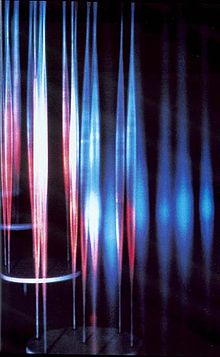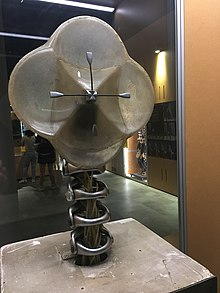Cybernetic Serendipity was an exhibition of cybernetic art curated by Jasia Reichardt, shown at the Institute of Contemporary Arts, London, England, from 2 August to 20 October 1968, and then toured across the United States. Two stops in the United States were the Corcoran Annex (Corcoran Gallery of Art), Washington, D.C., from 16 July to 31 August 1969, and the newly opened Exploratorium in San Francisco, from 1 November to 18 December 1969.
Content

One part of the exhibition was concerned with algorithms and devices for generating music. Some exhibits were pamphlets describing the algorithms, whilst others showed musical notation produced by computers. Devices made musical effects and played tapes of sounds made by computers. Peter Zinovieff lent part of his studio equipment - visitors could sing or whistle a tune into a microphone and his equipment would improvise a piece of music based on the tune.
Another part described computer projects such as Gustav Metzger's self-destructive Five Screens With Computer, a design for a new hospital, a computer programmed structure, and dance choreography.

The machines and installations were a very noticeable part of the exhibition. Gordon Pask produced a collection of large mobiles (Colloquy of Mobiles (1968)) with interacting parts that let the viewers join in the conversation. Many machines formed kinetic environments or displayed moving images. Bruce Lacey contributed his radio-controlled robots and a light-sensitive owl. Nam June Paik was represented by Robot K-456 and televisions with distorted images. Jean Tinguely provided two of his painting machines. Edward Ihnatowicz's biomorphic hydraulic ear (Sound Activated Mobile (SAM, 1968)) turned toward sounds and John Billingsley's Albert 1967 turned to face light. Wen-Ying Tsai presented his interactive cybernetic sculptures of vibrating stainless-steel rods, stroboscopic light, and audio feedback control. Several artists exhibited machines that drew patterns that the visitor could take away, or involved visitors in games. Cartoonist Rowland Emett designed the mechanical computer Forget-me-not, which was commissioned by Honeywell.
Another section explored the computer's ability to produce text - both essays and poetry. Different programs produced Haiku, children's stories, and essays. One of the first computer-generated poems, by Alison Knowles and James Tenney, was included in the exhibition and catalogue.
Computer-generated movies were represented by John Whitney's permutations and a Bell Labs movie on their technology for producing movies. Some samples included images of tesseracts rotating in four dimensions, a satellite orbiting the Earth, and an animated data structure.
Computer graphics were also represented, including pictures produced on cathode ray oscilloscopes and digital plotters. There was a variety of posters and graphics demonstrating the power of computers to do complex (and apparently random) calculations. Other graphics showed a simulated Mondrian and the iconic decreasing squares spiral that appeared on the exhibition's poster and book. The Boeing Company exhibited their use of wireframe graphics.
Keith Albarn & Partners contributed to the design of the exhibition.
Reflecting the prominence of music in the show, a ten-track album Cybernetic Serendipity Music was released by the ICA to accompany the show. Artists featured included Iannis Xenakis, John Cage, and Peter Zinovieff, a detail of whose graphic score for 'Four Sacred April Rounds’ (1968) was used as the cover artwork.
Attendance
Time magazine noted that there had been 40,000 visitors to the London exhibition. Other reports suggested visitor numbers were as high as 44,000 to 60,000. However, the ICA did not accurately count visitors.
After-effects
The exhibition provided the energy for the formation of British Computer Arts Society which continued to explore the interaction between science, technology and art, and put on exhibitions (for example Event One at the Royal College of Art). Several pieces were purchased by the Exploratorium in 1971, some of which are on display to this day.
In 2014 the ICA held a retrospective exhibition Cybernetic Serendipity: A Documentation which included documents, installation photographs, press reviews and publications and a series of discussions in one of which Peter Zinovieff took part. To coincide with the exhibition, Cybernetic Serendipity Music was re-released as a limited-edition vinyl LP by The Vinyl Factory.
The Victoria and Albert Museum marked the 50th anniversary with an exhibition in 2018 entitled "Chance and Control: Art in the Age of Computers". The V&A exhibition included many works by artists who featured in the original ICA show, plus related ephemera. "Chance and Control" subsequently toured to Chester Visual Arts and Firstsite, Colchester.
In 2020, The Centre Pompidou exhibited the replica of Gordon Pask's 1968 Colloquy of Mobiles, reproduced by Paul Pangaro and TJ McLeish in 2018.
In 2022 the Australian National University's School of Cybernetics launched the school by presenting an exhibition Australian Cybernetic: a point through time. The exhibition included works from Cybernetic Serendipity (1968), Australia ‘75: Festival of Creative Arts and Science (1975), and contemporary pieces curated by the School of Cybernetics. In describing Reichardt's Cybernetic Serendipity exhibition the school stated that it "represented points of expanding the cybernetic imagination" and was a "ground-breaking" "glimpse of a future in which computers were entangled with people and cultures, and through this she fashioned a blueprint for the future of computing that has since inspired generations".
See also
- Algorithmic art
- Computer art
- Cybernetics
- Electronic Art
- Generative art
- New Media Art
- Post-conceptual
- Systems art
- Virtual art
References
- Charlie Gere, ‘Minicomputer Experimentalism in the United Kingdom from the 1950s to 1980’ in Hannah Higgins, & Douglas Kahn (Eds.), Mainframe experimentalism: Early digital computing in the experimental arts. Berkeley, CA: University of California Press (2012), p. 119
- Acceptance speech for the AAM Distinguished Service Award - June 21, 1982, transcript, Frank Oppenheimer, Exploration and Discovery magazine, p9, San Francisco, CA.
- ^ "Computer World: Why Cybernetic Serendipity Music is the most important and neglected compilation in electronic music | Page 2 of 5". The Vinyl Factory. 15 October 2014. Retrieved 26 June 2021.
- "Home". colloquyofmobiles. Retrieved 18 July 2021.
- "The Honeywell-Emett 'Forget-Me-Not' (Pheripheral Pachyderm) Computer". Chris Beetles Gallery. Archived from the original on 29 November 2014. Retrieved 18 November 2013.
- "Computerized Haiku". in-vacua.com. Retrieved 5 August 2019.
- Mendoza, E. "High-Entropy Essays". in-vacua.com. Retrieved 5 August 2019.
- Reichardt, Jasia, ed. (1968). "Cybernetic Serendipity - The Computer and the Arts; a Studio international special issue". Studio International. London: The Studio Trust. p. 7. OCLC 497641989. Retrieved 20 June 2020.
- Licht, Alan (March 2015). "Alan Licht on Cybernetic Serendipity Music". www.artforum.com. Archived from the original on 31 October 2020. Retrieved 21 July 2021.
- "Cybernetic Serendipity". Cybernetic Serendipity. Retrieved 21 July 2021.
- "Cybernetic Serendipity". Time. 6 October 1968. Archived from the original on 23 February 2009. Retrieved 8 October 2008.
- "Cybernetic Serendipity | Database of Digital Art". dada.compart-bremen.de.
- "PAGE 1" (PDF). BCS. 6 April 1969. Retrieved 23 October 2008.
- "Exhibit Collections: Cybernetic Serendipity". Exploratorium. Retrieved 18 July 2021.
- "Cybernetic Serendipity: A Documentation". archive.ica.art. Retrieved 21 July 2021.
- Dodds, Douglas (2019). "Chance and Control: Art in the Age of Computers". Art in Print. 8 (5): 3–9.
- "Chance and Control: Art in the Age of Computers". Victoria and Albert Museum. Retrieved 12 May 2022.
- "Colloquy of Mobiles". colloquyofmobiles. Retrieved 18 July 2021.
- "Australian Cybernetic: a point through time". Australian National University, School of Cybernetics. Retrieved 21 September 2023.
- Reichardt, Jaisa (29 November 2017). "Nick Wadley Obituary". The Guardian. Retrieved 22 September 2023.
External links
- Reichardt, Jasia, ed. (1968). "Cybernetic Serendipity - The Computer and the Arts; a Studio international special issue". Studio International. London: The Studio Trust. OCLC 497641989.
- Fernandez, Maria (Fall 2008). "Detached from history: Jasia Reichardt and Cybernetic Serendipity". Art Journal. 67 (3): 6–23. doi:10.1080/00043249.2008.10791311. JSTOR 40598908. S2CID 193026727.
- Usselmann, Rainer (October 2003). "The Dilemma of Media Art: Cybernetic Serendipity at the ICA London". Leonardo. 36 (5): 389–396. doi:10.1162/002409403771048191. S2CID 57564123.
- MacGregor, Brent (October 2002). "Cybernetic serendipity revisited". Proceedings of the fourth conference on Creativity & cognition - C&C '02. pp. 11–13. doi:10.1145/581710.581713. ISBN 978-1581134650. S2CID 6322799. (requires membership)
- "Cybernetic Serendipity". 26 July 2006. Retrieved 8 October 2008.
- "Cybernetic Serendipity". compArt database Digital Art (daDA). Retrieved 9 January 2014.
- "Late Night Line-up". YouTube. 8 October 2013. (contemporary TV report, presented by Jasia Reichardt)
- "Cybernetic Serendipity". Retrieved 20 November 2014.
- "Thomas Dreher: History of Computer Art, chap. II.3.2 Cybernetic Serendipity". Retrieved 30 August 2016.